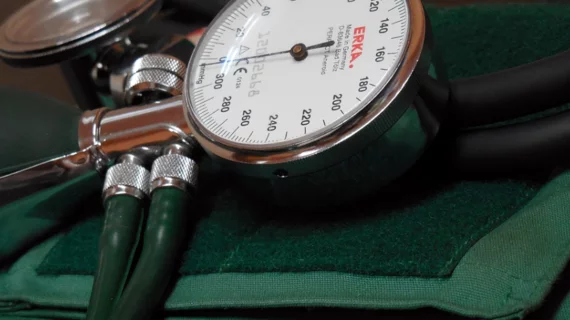Diastolic BP of 80-89 mmHg could double CVD risk for CAD patients
A new study published in European Heart Journal found patients with stable or controlled coronary artery disease (CAD) who have a diastolic blood pressure reading of 80-89 mmHg may have an increased risk for cardiovascular disease (CVD). A systolic blood pressure reading of 130-139 mmHg was not associated with an increased risk for CVD.
The researchers, led by Philippe Gabriel Steg, MD, of the Bichat-Claude Bernard Hospital in Paris, sought to investigate the relationship between blood pressure and cardiovascular disease in patients with CAD, who had blood pressure readings of less than 140/90 mmHg. The 140/90 mmHg reading was previously considered normotensive, until the recent 2017 American College of Cardiology/American Heart Association (ACC/AHA) hypertension guidelines went into effect, which denote less than 130/80 mmHg as being normotensive.
They specifically sought to assess individuals with blood pressure readings of less than 140/90 mmHg as they “represent the epitome of high-risk patients to whom the lowered pharmacological intervention threshold in the recent ACC/AHA guideline applies.”
Steg and colleagues reviewed data from almost 6,000 patients with CAD, who had no history of hypertension or heart failure, with an average blood pressure reading of less than 140/90 mmHg. At baseline and each yearly visit for up to five years, the researchers collected patients’ health data, including symptoms and blood pressure readings from clinical examinations.
After a follow-up of five years, Steg and colleagues found cardiovascular death occurred in 114 patients, myocardial infarction occurred in 48 patients and stroke occurred in 29 patients.
Diastolic blood pressure readings of 80-89 mmHg (with a systolic reading of less than 140 mmHg) more than doubled the risk of developing cardiovascular death, myocardial infarction or stroke, compared to readings of 70-79 mmHg.
Individuals with systolic blood pressure readings of 130-139 mmHg do not have a higher risk of developing adverse cardiovascular outcomes, compared to readings between 120-129 mmHg.
“Although observational, our data do not support initiation of BP-lowering therapy (or more-intensive treatment in those receiving antianginal blood pressure-lowering drugs) in patients newly defined as hypertensive according to the 2017 AHA/ACC guideline because of a systolic blood pressure between 130 and 139 mmHg,” the researchers wrote.

